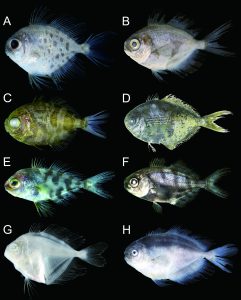Abstract / Introduction / Summary:

The family Nomeidae, known as drift fishes, is distributed circumglobally in tropical and subtropical marine waters (Ahlstrom, 1976; Nelson, 2006). This family is characterized by a compressed body, a blunted or rounded snout, the terminal mouth, two associated dorsal fins, and a forked caudal fin with the absence of lateral keels (Last, 2001; Nelson, 2006). The three genera namely Cubiceps Lowe, 1843, Nomeus Cuvier, 1816, and Psenes Valenciennes, 1833 are regarded as valid: Cubiceps is characterized by an elongated body with long pectoral fins and 15–23 and 14–22 dorsal- and anal-fin soft rays respectively; Nomeus by a slender body with blotches on body and fins and 23–27 and 24–28 dorsal- and anal-fin soft rays respectively; and Psenes by a deep and compressed body with 19–32 and 20–35 dorsal- and anal-fin soft rays respectively (Last, 2001; Nakabo, 2002) A total of 118 nomeid specimens collected from Kagoshima Prefecture and deposited at the Kagoshima University Museum (KAUM) was examined in this study. As a result, these specimens were identified as C. whiteleggii (Waite, 1894), N. gronovii (Gmelin, 1789), P. arafurensis Günther, 1889, P. cyanophrys Valenciennes, 1833, P. maculatus Lütken, 1880 and P. pellucidus Lütken, 1880. In this paper, morphological features, especially meristics, of nomeid fishes collected from Kagoshima Prefecture are provided for reference data.
